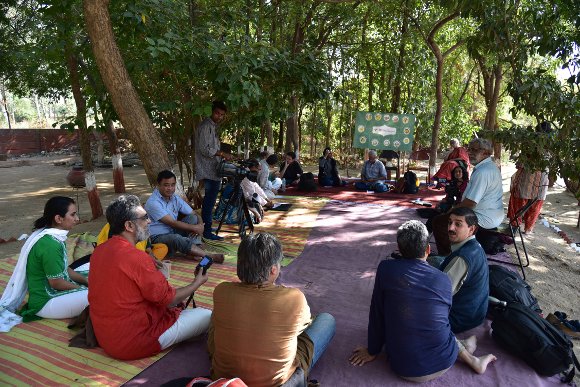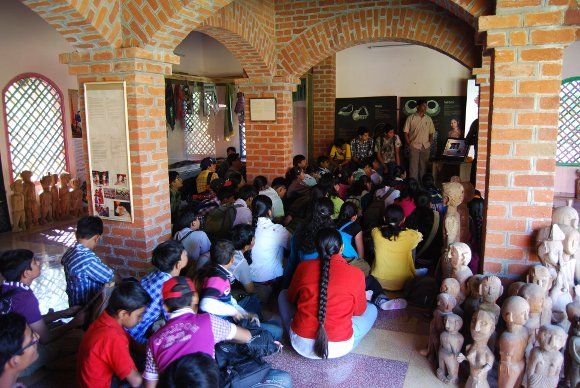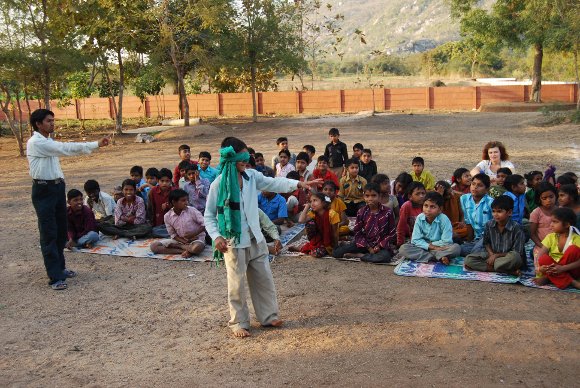“Did you know that Himachal Pradesh has 220 terms for snow? Separate words depending on when, where and how it falls.” I looked incredulously at the speaker as he continued.
“Diversity is the key to life’s evolution and a crucial part of this is the range of languages we have in India, and the range and meaning of terms within each language. According to us, there are at least 850 living languages in India, not dialects, full languages.”
The speaker was Ganesh Devy, linguist extraordinaire, and I was at the Adivasi Academy at Tejgadh, near Vadodara, Gujarat. The Academy is a learning institute set up in 1999 by Bhasha Research and Publication Centre, an organization Devy started in 1996. As its name suggests, the core of Bhasha’s work is on languages, but this includes a whole set of related economic, political, cultural and social aspects.
How does Devy know there are 850 languages in India? He told us about what must surely be one of the world’s most extensive cultural exercises, the Peoples’ Linguistic Survey of India, conducted from 2010 to 2013. This survey documented 780 languages.
Why a peoples’ survey
Devy explains: “In the 1961 census, a total of 1652 ‘mother tongues’ were recorded in India; in 1971, this had come down to 108 simply because all languages with less than 10000 speakers had been clubbed into a generic ‘others’ category; by 2001, the official figure stands at 122! Of these, only 22 are in the Eighth Schedule of the Constitution. Most other languages are treated as ‘dialects’ because they don’t have a script, but if you think of a language as something that has its own independent grammar, and most of its wordstock governed by that grammar, these so-called dialects are also full languages. For a long time Oriya - a major language - was seen as a ‘dialect’ of Bangla, and Konkani as a ‘dialect’ of Marathi. In any case even English does not have its own script!
There are nearly 500 adivasi languages, some like Bhili with over 9.5 million speakers recorded in the 2001 census, some like the languages of the Onge, Greater Andamanese and Sentinelese adivasis of the Andaman & Nicobar Islands with only a few hundred speakers! And the Majhi spoken in Sikkim has barely four or five speakers now. Arunachal Pradesh alone has nearly 90 languages. In fact we documented about 200 languages about which no documentation previously existed outside of the community speaking them.”

The Peoples’ Linguistic Survey, involving over 3000 collaborators, has resulted in about 50 volumes in 92 books at various stages of print.
Belatedly the government has recognized the stupendous effort and is using the results in various ways. Bhasha’s work on languages and adivasi cultures is now one basis for starting special research centres in 10 central universities and 12 state universities, and commissioning related activities in state tribal welfare institutions.
But it will take much more governmental and civil society action to reverse the slide of hundreds of languages towards either extinction or irreversible damage (Devy uses the term ‘aphasia’ to denote this silencing of languages), including breaking out of the imposition of dominant languages in schools, re-assertion of the importance of oral transmission, techniques of respectful cross-language communication, and much else.
Gujarat, for instance, has 52 languages, of which only 3 - Gujarati, Urdu and Sindhi - are mentioned in the Eighth Schedule, and very few are taught in schools. Kachchhi, an independent language spoken by lakhs, is not even recognized!
In the corridors of power, says Devy, “If every language is a unique worldview then statistically not more than four per cent of Indian worldviews have been articulated in the Parliament.” If in 1961 there were indeed 1600+ languages, it could mean that several hundred are already gone or at least untraced. Devy says that 220 languages have definitely disappeared in the last 50 years, another 150 could be lost in the next few decades.
Why is it important to reverse the erasure of language diversity
Devy explains ,“Languages are repositories of knowledge, of relationships between humans and nature and humans with each other, their loss entails the loss of all this. Who knows how important Himachal’s diverse terms for snow will be to tackle climate change that is impacting glaciers and snowmelt and precipitation? Or of the thousands of terms for foods and food habits, to the nutritional security of the poor?”
The language survey is only the latest in a long line of pathbreaking initiatives that Bhasha has undertaken. Over the years it has put together a repository of tribal arts, with 60000 photographs taken by adivasis themselves; in the same vein of participatory or community-led documentation, there are over 90 ‘insider ethnographies’ of communities being prepared, as also over 3000 adivasi dictionaries and several hundred adivasi folklore volumes are in the process of compilation.
Documentation is also taking place of nomadic, coastal, and pastoral communities. At the Adivasi Academy, Naranbhai Rathwa, a local Rathwa adivasi who has been with Bhasha almost since it began, and has by now acquired an MA in Sociology, has designed an interactive, live ‘museum’ (Vacha) that has artefacts, instruments, vessels, art, photos, clothing, and other aspects of adivasi culture from southern Gujarat and elsewhere.
Awareness session with students at Vacha, Adivasi Academy, Vadodara. Pic: Ashish Kothari
Vacha and near to it, Lakhara (an artists’ studio), have become the locus of several exciting events including adivasi music and art festivals.
As Naranbhai explains: “Vacha is a forum and a platform for expression of adivasi creativity, providing intellectual space for adivasis interested in documenting social practices, and creating dynamic displays of adivasi expressions, both artistic and cultural, a 'laboratory'—or rather a ‘curatory’-- for contemporary ethnic, anthropological and artistic studies carried out from the perspective of adivasis themselves. It is conceptualized as a unique Museum of Voice.”
Bhasha’s cultural centre for nomadic communities located in Ahmedabad has created a ‘Museum of Hope’ in the midst of what was previously the prison settlement for the Chhara tribe, and a ‘Himlok museum’ at Kyelang in Himachal Pradesh, at 11000 feet altitude, for revitalizing the Himalayan memory-scape.
The learning space
The Academy also houses a clinic for basic healthcare, where the first thing that is advised is to take ‘no medicine’ and let the body heal, but there is readiness for also offering cures using various health systems. At a nominal medical insurance fee of Rs. 200 per year, every adivasi of the area is entitled to free services at the clinic.
In another corner of the Academy’s campus is Vasant Shala, learning centre for young children, where over the years 20000 kids have done their first few years of learning.
Learning through games at Vasant Shala, Adivasi Academy, Vadodara. Pic: Ashish Kothari
This institution has no standard medium of instruction, the teachers are supposed to learn any mother tongue that a child comes with, teaching and learning happens in multiple languages, and there are no grades with various age groups studying together.
The Academy also catered to college-going adivasi youth from 2000 to 2012, providing a diploma course in ‘normal’ studies like engineering and computers and the like, while also learning adivasi studies, practical skills and other aspects enabling them to retain roots in their own cultures and ecologies.
It is after Bhasha was invited to collaborate with various UGC institutions that these courses were modified as ‘orientation courses’ in multi-lingual education and folklore studies.
Faculty for both the school and the college have not been only formally trained academics, but also village experts like Mansignh Rathwa, a Pithora painter who has never attended a school. A library in the campus contains over 30000 volumes and 185 journals, in multiple languages. But in all the programmes, great emphasis is given to oral learning, performing arts, and other non-written forms, respecting that adivasis have for millennia used such diverse mediums of expression and knowledge transmission.
Producing certificates of formal degrees is not a requirement for recruitment at the Academy, and whoever desires to join it is allowed to do the work they like to do. But their performance is regularly assessed by their peers. Given all this, it is not surprising that the Academy is recognized as a Centre of Excellence by the Union Ministry of Tribal Affairs.
The latest addition to the Academy campus is the Bhasha Van (Language forest), where samples and information about each of the 780 languages Bhasha has documented will be available in recordings for visitors to listen to. So far 70 languages have been placed under 70 trees, each identified with an attractive plaque (tied rather than nailed to the tree!), and visitors are provided headsets to listen to them.
The Denotified Tribes
Devy is also well-known for his work on the Denotified Tribes (DNTs) and nomadic/semi-nomadic tribes. He explained to us the history: “In 1871 the colonial government notified several communities as criminal tribes, largely because as nomadic or mobile peoples they did not confirm to the British government’s notion of a legitimate community. In 1952 the Indian government denotified them to remove the stigma (hence DNTs), but little attempt was made to give them the recognition that would bring back dignity and legitimacy in the eyes of the larger public; in fact, shockingly, they were reclassified as ‘habitual offenders’ under a law by the same name in 1959! Occupationally, socially, culturally and in other ways they remained marginalized, and even shunned. Even now there are communities or families under this category who require permission from the district authorities to travel outside the district!”
Unfortunately the sorry plight of DNTs has continued well into the 21st century, many of them not even on voters’ lists till recently, many forced to settle into sedentary existence that goes against their very grain, many others now begging in the city streets of modern India.
Bhasha launched the Denotified and Nomadic Tribes Rights Action Group (DNT-RAG) in 1998 to create a national campaign for protection of their rights, as a result of which the Government of India established the National DNT Commission and the Technical Advisory Group (TAG), chaired by Devy and with 6 other activists/scholars as members. After the submission of the TAG Report to the Government, the DNT-RAG was dissolved in 2008.
Like so many other good reports, though, it lies gathering dust in the corridors of power. Kanjibhai Patel of the Lunawada College, a long-time associate of Devy’s told us that Bhasha’s attempts to highlight these issues, and facilitate DNTs own voice, through national level networking and advocacy, providing spaces for their cultural expression such as the Budhan Theatre in Ahmedabad, and hosting an annual festival of DNTs at Kaleshwari in the Panchmahals in March that started with a few hundred people and is now 20000-plus strong.
Bhasha's mission
At the heart of Bhasha’s work is a deep commitment to freedom and independence, including that of speech and expression. At Bhasha’s office in Vadodara where Devy, his wife Surekha Dalvi and colleagues Kanjibhai Patel and Sonalbehn Baxi welcomed us, I noticed a bewildering array of trophies and award citations from various parts of the world. It is but natural that work of this order is awarded.
Notably, though, Devy recently returned his Sahitya Academy award as part of the growing number of writers, artists, scientists, academics and others who are doing this to express “concern and anxiety over the shrinking space for free expression and growing intolerance towards difference of opinion” and the growing atmosphere of communal hatred and intolerance that the BJP government is abetting.
It takes courage to make such a visible gesture when one is based in Gujarat, but Devy has gone even beyond that by organizing, with others like him, journeys into other states to talk about these issues with anyone who is willing to listen. As he says, “The great idea of India is based on a profound tolerance for diversity and difference”, and anything undermining this is playing with the very foundations of the country.

Vikalp Sangam Core Group meeting, Adivasi Academy. Pic: Ashish Kothari
My visit to Bhasha and the Adivasi Academy was on the occasion of the meeting of the Core Group of Vikalp Sangam, of which Bhasha is a member. It was appropriate for us to organize it here, given Bhasha’s multiple roles in stemming the bulldozer of cultural homogenization that has come with colonialism first and now economic globalization, and in providing alternatives in learning, cultural spaces, and other aspects of community life.
The Vikalp Sangam process attempts to bring together transformative and alternative approaches to development, that people across India are practicing and conceiving of, and through this build a common vocabulary of both resistance and reconstruction towards a sustainable, equitable, and just future. Language and more generally, cultural diversity is surely a fulcrum of such an endeavor. Therein lies the importance of what Bhasha is trying to do.

























